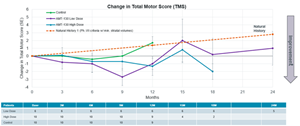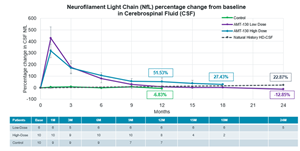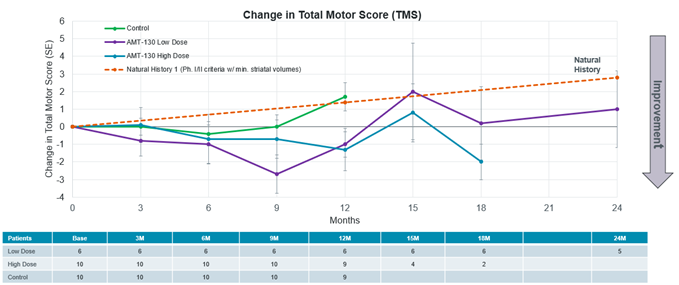uniQure Announces Update on U.S. Phase I/II Clinical Trial of AMT-130 Gene Therapy for the Treatment of Huntington’s Disease


Change in Total Motor Score


Neurofilament Light Chain (Nfl) percentage change from baseline in Cerebrospinal Fluid (CSF)


~ AMT-130 continues to be generally well-tolerated across both dose cohorts ~
~ Patients treated with AMT-130 show preserved function compared to baseline and clinical benefits relative to natural history of the disease ~
~ Neurofilament Light Chain (NfL) in cerebrospinal fluid (CSF) was below baseline at 24 months in patients treated with the low-dose of AMT-130 and declining towards baseline at 12 months in patients treated with the high-dose of AMT-130 ~
~ Suppression of CSF mHTT in low-dose cohort supports AMT-130 target engagement; Greater variability observed in high-dose cohort ~
~ Promising data support continuing clinical development of AMT-130 and pursuing regulatory interactions to discuss late-stage development ~
~ Investor conference call and webcast today at 8:30 a.m. ET ~
LEXINGTON, Mass. and AMSTERDAM, June 21, 2023 (GLOBE NEWSWIRE) -- uniQure N.V. (NASDAQ: QURE), a leading gene therapy company advancing transformative therapies for patients with severe medical needs, today announced promising interim data, including up to 24 months of follow-up, from 26 patients enrolled in the ongoing U.S. Phase I/II clinical trial of AMT-130 for the treatment of Huntington’s disease.
“We are very pleased with the data from the interim analysis of our U.S. Phase I/II clinical trial of AMT-130, a one-time administered investigational gene therapy for Huntington’s Disease,” stated Ricardo Dolmetsch, Ph.D., president of research and development at uniQure. “AMT-130 continues to be generally well-tolerated with a manageable safety profile at both doses. Importantly, both doses show preliminary evidence of clinical and functional benefits, including favorable trends in Total Motor Score, Total Functional Capacity and the composite Unified Huntington’s Disease Rating Scale compared to natural history. We plan to engage with regulators to advance this promising clinical program as we collect more data from these patients and from our European study.”
“Today’s encouraging interim update shows early signs of a potential clinical benefit of AMT-130 and supportive trends in neurofilament light chain, a key marker of neuronal damage that has proven useful across multiple neurodegenerative disorders,” stated Sarah Tabrizi, M.D., FRCP, Ph.D., professor of clinical neurology, director of the University College London (UCL) Huntington’s Disease Center and joint head of the department of neurodegenerative disease at UCL. “Despite the small patient numbers, I am encouraged to see that patients treated with either dose of AMT-130 appear to have largely preserved function and are trending favorably to natural disease course at up to 24 months. These interim results provide early hope for patients suffering from this devastating disease, and I look forward to additional clinical updates and the further investigation of AMT-130 as a potentially important treatment option for patients with Huntington’s disease.”
Data Summary from the U.S. Phase I/II Trial of AMT-130 in Huntington’s Disease
A total of 26 patients with early-manifest Huntington’s disease have been enrolled in the multi-center, U.S. Phase I/II clinical trial of AMT-130, including a 10-patient low-dose cohort (6 treated, 4 control) and a 16-patient, high-dose cohort (10 treated, 6 control). Patients were randomized to treatment with AMT-130 or an imitation (sham) surgery. The study consists of a blinded 12-month core study period followed by unblinded long-term follow-up of five years for treated patients. To date, four of the six control patients in the high dose cohort have been crossed over to treatment. Efficacy and biomarker data from the crossover patients are not included in the summary below.
Safety and Tolerability
AMT-130 was generally well-tolerated, with a manageable safety profile in patients treated with the lower dose of 6x1012 vector genomes and the higher dose of 6x1013 vector genomes. The most common adverse events in the treatment groups were related to the surgical procedure. No treatment emergent adverse events (TEAEs) led to discontinuation of patient follow-up.
As previously reported, there were two serious adverse events (SAE) unrelated to AMT-130 (post-operative delirium and major depression) in the low-dose cohort, one SAE in the high-dose cohort (back pain), and one SAE (deep vein thrombosis) in the control group. In addition there were two suspected unexpected serious adverse events (severe headache, central nervous system inflammation) in the high-dose cohort. All the events have resolved.
All four crossover patients (3 high dose, 1 low dose) received a short course of immunosuppression therapy concurrent with the administration of AMT-130. Following a review of the interim data analysis, the Data Safety Monitoring Board (DSMB) for the U.S. Phase I/II clinical trial concluded there are no safety concerns with either dose and recommended continuing clinical development of AMT-130.
Exploratory Efficacy Data
Clinical and functional measurements for treated patients in each dose cohort were compared to baseline measurements, control patients (up to 12 months) and a natural history cohort. The natural history cohort was developed by uniQure in collaboration with the Cure Huntington’s Disease Initiative (CHDI) using the TRACK-HD natural history study of patients with early Huntington’s disease. The cohort includes 31 patients that met the uniQure clinical trial inclusion-criteria of CAG length, age, Total Functional Capacity, Diagnostic Classification Level and minimum striatal volumes.
Early clinical data demonstrate trends consistent with a potential clinical benefit of AMT-130 at both doses of AMT-130.
Compared to baseline measurements, clinical function was generally preserved at 24 months for patients in the low-dose cohort and at 12 months for patients in the high-dose cohort.
Compared to natural history, patients in both dose cohorts demonstrated benefits in each of Total Motor Score, Total Functional Capacity and the composite Unified Huntington’s Disease Rating Scale.
Total Motor Score (TMS): Low-dose patients demonstrated a mean improvement in TMS of 1.8 points at 24 months compared to natural history and high-dose patients demonstrated a mean improvement of 2.7 points at 12 months.
Total Functional Capacity (TFC): Low-dose patients demonstrated a mean 0.8 point improvement in TFC at 24 months compared to natural history and high-dose patients demonstrated a mean 0.5 point improvement at 12 months.
Composite Unified Huntington’s Disease Rating Scale (cUHDRS): Low-dose patients demonstrated a mean 0.9 point improvement in cUHDRS at 24 months compared to natural history and high-dose patients demonstrated a mean 1.0 point improvement at 12 months.
Patients in the control group experienced a worsening of Total Motor Score at 12 months compared to baseline and natural history. TFC and cUHDRS was preserved in control patients at 12 months.

Biomarkers
Neurofilament light chain (NfL)
As expected and as previously reported, patients treated with AMT-130 experienced a transient increase in CSF NfL related to the procedure that peaked at approximately one month after administration. These transient increases were not dose-dependent and all patients experienced subsequent declines in CSF NfL.
Mean CSF NfL for the low-dose cohort was 12.9% below baseline compared to a predicted 22.9% increase in the natural history, with four of the five low-dose patients having CSF NfL levels below baseline.
CSF NfL levels in the high-dose cohort were more variable through 12 months, with a mean increase of 51.5% compared to baseline. Four of the eight high-dose patients with at least 12 months of follow-up had NfL levels below baseline. Two high-dose patients with 18 months of follow-up demonstrated a continued decline in CSF NfL to 27.4% above baseline.
In the control group, mean CSF NfL was relatively stable and was 6.83% below baseline at 12 months.

Mutant Huntingtin protein (mHTT)
CSF mHTT for the low-dose cohort remained below baseline with a mean reduction of 8.1% at 24 months. CSF mHTT for the high-dose cohort was significantly more variable with a mean increase of 39.7% above baseline at 12 months compared to a 4.7% increase in the control group. Three of nine evaluable patients in the high-dose cohort had CSF mHTT reduction below baseline at their last measurement.
Total Brain Volume
The mean total brain volume for the control, low-dose and high-dose cohorts declined 0.74%, 1.02% and 1.23%, respectively at 12 months and were not significantly different from each other or from the natural history.
Next Steps
Based on the promising data from this interim analysis, uniQure will advance the clinical development of AMT-130 and anticipates the following next steps:
Early in the third quarter of 2023, uniQure expects to complete patient enrollment in the high-dose cohort of the European clinical trial.
In the second half of 2023, uniQure expects to initiate a third cohort in the ongoing U.S. clinical trial to further investigate both doses in combination with perioperative immunosuppression with a focus on evaluating near-term safety. The third cohort will enroll up to 10 patients, all of whom will receive AMT-130 using the current, established stereotactic neurosurgical delivery procedure.
In the fourth quarter of 2023, uniQure expects to present new clinical data from the Phase I/II studies of AMT-130, including additional follow-up data from the treated patients in the U.S. trial and 12-month follow-up data from the low-dose patients in the EU trial.
By the first quarter of 2024, uniQure anticipates holding regulatory interactions to discuss data from the U.S. and EU studies and the pathway for further advancing the clinical development of AMT-130.
Investor Conference Call and Webcast Information
uniQure management will host an investor conference call and webcast today, Wednesday, June 21, 2023 at 8:30 a.m. ET. The event will be webcast under the Events & Presentations section of uniQure’s website at https://www.uniqure.com/investors-media/events-presentations and following the event a replay will be archived for 90 days. Interested parties participating by phone will need to register using this online form. After registering for dial-in details, all phone participants will receive an auto-generated e-mail containing a link to the dial-in number along with a personal PIN number to use to access the event by phone. If you are joining the conference call, please dial in 15 minutes before the start time.
About the Phase I/II Clinical Program of AMT-130
The U.S. Phase I/II clinical trial of AMT-130 for the treatment of Huntington’s disease is exploring the safety, tolerability, and efficacy signals in 26 total patients with early manifest Huntington’s disease split into a 10 patient, low-dose cohort followed by a 16 patient, high-dose cohort; patients are randomized to treatment with AMT-130 or an imitation (sham) surgery. The multi-center trial consists of a blinded 12-month core study period followed by unblinded long-term follow-up for five years. A total of 16 patients in the clinical trial were randomized to treatment and received a single administration of AMT-130 through MRI-guided, convection-enhanced stereotactic neurosurgical delivery directly into the striatum (caudate and putamen). An additional four control patients in the high-dose cohort crossed over to treatment. Additional details are available on www.clinicaltrials.gov (NCT04120493).
The European, open-label Phase Ib/II study of AMT-130 will enroll 15 patients with early manifest Huntington’s disease across two dose cohorts. The low-dose cohort of six patients has completed enrollment with the remaining high-dose cohort expected to complete enrollment in mid-2023. Together with the U.S. study, the European study is intended to establish safety, proof of concept, and the optimal dose of AMT-130 to take forward into Phase III development or into a confirmatory study should an accelerated registration pathway be feasible.
AMT-130 is uniQure’s first clinical program focusing on the central nervous system (CNS) incorporating its proprietary miQURE® platform.
About Huntington’s Disease
Huntington’s disease is a rare, inherited neurodegenerative disorder that leads to motor symptoms including chorea, and behavioral abnormalities and cognitive decline resulting in progressive physical and mental deterioration. The disease is an autosomal dominant condition with a disease-causing CAG repeat expansion in the first exon of the huntingtin gene that leads to the production and aggregation of abnormal protein in the brain. Despite the clear etiology of Huntington’s disease, there are no currently approved therapies to delay the onset or to slow the disease’s progression.
About uniQure
uniQure is delivering on the promise of gene therapy – single treatments with potentially curative results. The recent approvals of uniQure’s gene therapy for hemophilia B – a historic achievement based on more than a decade of research and clinical development – represents a major milestone in the field of genomic medicine and ushers in a new treatment approach for patients living with hemophilia. uniQure is now leveraging its modular and validated technology platform to advance a pipeline of proprietary gene therapies for the treatment of patients with Huntington's disease, refractory temporal lobe epilepsy, ALS, Fabry disease, and other severe diseases. www.uniQure.com
uniQure Forward-Looking Statements
This press release contains forward-looking statements within the meaning of Section 27A of the Securities Act of 1933, as amended, and Section 21E of the Securities Exchange Act of 1934, as amended. All statements other than statements of historical fact are forward-looking statements, which are often indicated by terms such as "anticipate," "believe," "could," “establish,” "estimate," "expect," "goal," "intend," "look forward to," "may," "plan," "potential," "predict," "project," “seek,” "should," "will," "would" and similar expressions and the negatives of those terms. Forward-looking statements are based on management's beliefs and assumptions and on information available to management only as of the date of this press release. These forward-looking statements include, but are not limited to, the potential clinical and functional effects of AMT-130, including as an important treatment option for patients with Huntington’s disease, the expected completion of enrollment of the European, open-label Phase Ib/II study of AMT-130, and the initiation of a third cohort in the ongoing U.S. Phase I/II clinical. uniQure’s actual results could differ materially from those anticipated in these forward-looking statements for many reasons, including risks related to conducting the clinical trial for Huntington’s disease, the impact of financial and geopolitical events on uniQure and the wider economy and health care system, uniQure’s clinical development activities, clinical results, collaboration arrangements, regulatory oversight, product commercialization and intellectual property claims, as well as the risks, uncertainties and other factors described under the heading "Risk Factors" in uniQure’s periodic securities filings, including its Annual Report on Form 10-K filed with the SEC on February 27, 2023 and its Quarterly Report on Form 10-Q filed with the SEC on May 9, 2023. Given these risks, uncertainties and other factors, you should not place undue reliance on these forward-looking statements, and uniQure assumes no obligation to update these forward-looking statements, even if new information becomes available in the future.
uniQure Contacts:
FOR INVESTORS: |
|
|
| FOR MEDIA: |
|
|
|
|
|
Maria E. Cantor |
| Chiara Russo |
| Tom Malone |
Photos accompanying this announcement is available at
https://www.globenewswire.com/NewsRoom/AttachmentNg/b4b22dda-4970-4ea5-bf8e-07bfb2b1faca
https://www.globenewswire.com/NewsRoom/AttachmentNg/e8da9727-930c-46a5-8f09-5b1df481db08

